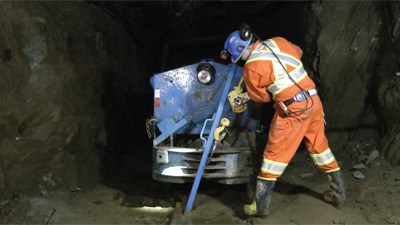Dumas Contracting has won the 2012 Safety Innovation Award from the Ontario Mine Contractors Safety Association (OMCSA) for a new method of re-railing errant locomotives.
The traditional method of re-railing tracked equipment is a five-step process requiring the use of jacks and blocking to lift the unit up and slide it over. Because there is no other means of transportation available on a level when a locomotive comes off the tracks, workers have to travel on foot to collect heavy wooden timbers and carry them back to the site of the derailment.
Re-railing equipment using this method is time-consuming, cumbersome and rated as high-risk. Hands get caught between the blocking and the rail, jacks kick out and backs give out from bending and carrying heavy loads.
Dumas’s award-winning re-railer bar does away entirely with jacks and blocking. The bar is wedged against the track at an angle and a come-along is used to slide the unit over and onto the tracks. All of the tools required are carried on the locomotive, eliminating the hike to locate and retrieve heavy timbers.
Using the re-railing bar, workers are able to return the locomotive to the tracks in a fraction of the time and with a much lower risk of injury.
Dumas got the idea from a mine in Quebec that was using a similar method and sent safety and training co-ordinator Rick Kenny to investigate. Kenny brought the concept back to Timmins and worked with miners, engineers and maintenance staff to perfect it.
The re-railer bar was put to the test on track haulage levels at Goldcorp’s Dome Mine and is well on its way to being adopted as the preferred method of putting tracked equipment back on the rails.
Dumas also won the OMCSA Safety Innovation Award in 2010 for developing a safer way to transport miners underground during shaft sinking operations.
A caged crosshead developed by Dumas sits immediately above the bucket used to transport miners through the shaft, preventing them from sticking out their heads or arms.
The idea was developed after a mechanic with another company in Quebec was fatally injured during a shaft sinking operation.
“There have been several deaths during shaft sinking operations when people failed to stay within the confines of the bucket,” including “one death of a shaft miner in Ontario who was killed when he leaned over the edge of the bucket,” according to Dumas’s innovation award submission.
“It’s like a ride at Canada’s Wonderland, so they like to look out,” said Dumas vice- president Greg Hart. “As a result, some guys have been decapitated or had their arms mangled. It was a pretty simple idea, but everybody’s adopting it.”
A proximity switch on the crosshead door prevents the hoist from moving if the door is open and a bell cord installed within the crosshead eliminates the need to reach outside the bucket.
The caged crosshead was used throughout the entire shaft sinking process at Lake Shore Gold’s Timmins Mine.


